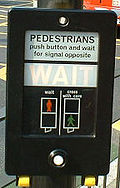Pedestrian Crossings used to be simple things where you pressed a button and light went on saying 'wait' and then you waited until the red man turned to a green man.
However, modern crossings in the UK are 'computerised' and react to the inputs from a number of sensors - so that their time to react to pressing the button is variable.
Would it therefore be useful to have some kind of display on the 'wait' panel which gave an indication of 'processing' - such as the ubiquitous spinning disk icon - or would a more complex indicator be required ?
Edit: Observing people's actual behaviour at crossings shows that people often don't 'obey' the crossing but make their own decisions about when to cross.
I'd argue that this is down to the apparently 'random' behaviour of computerised crossings (sometimes it reacts quickly when you press the button, sometimes it reacts slowly).
And there is no feedback from the crossing display indicating that anything is happening ( on software you'd use a 'loading' indicator )

 Image by Secretlondon from
Image by Secretlondon from